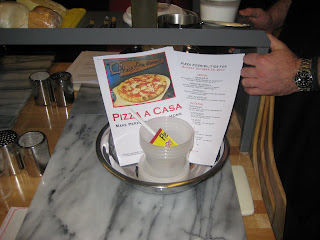
Cool weather and college football got me craving chili. But, as you may recall, I have a phobia of industrial ground beef. So I decided to make it myself, using a recipe (from Tom Valenti's "Soups, Strews, and One-Pot Meals" - great cookbook) that calls for [ammonia free] cubes of beef stew meat. The result was delicious, especially when served with some brown rice and topped with grated cheddar cheese, finely chopped red onion, and a little sour cream.
2 lbs beef chuck, cut into 1-inch cubes
1 tablespoon garlic powder
1 tablespoon chile powder
2 tablespoons olive oil
2 carrots, peeled and diced
1 celery stalk, diced
1 medium onion, peeled and diced
2 bell peppers (I used one red and one green), seeded and diced
10 cloves of garlic, peeled and minced
2 tablespoons tomato paste
pinch of sugar
2 tablespoons all-purpose flour
1 tablespoon distilled white vinegar
1 quart beef low-sodium broth
1 cup diced tomatoes (I used canned - you can also use 4 fresh plum tomatoes)
1 teaspoon ground cumin
1 dried ancho chile,* seeded, stemmed and chopped
2 15 oz cans of red kidney beans, drained and rinsed
kosher salt
ground pepper
*I found a bag of ancho chiles Fairway, some chopped canned chipotle in adobo would also probably be good
What to do:
1. Put the meat in a bowl and season with one tablespoon of kosher salt, 1 tablespoon of ground pepper, the garlic powder and chili powder. Stir so the meat is covered in the spice mixture.
2. Heat olive oil in a large pot/dutch oven over medium-high heat. Add the seasoned meat and cook until browned all over, 8 - 12 minutes. Remove meat from the pot and set aside.
3. Add the carrots, onion, celery, peppers, and garlic and stir, scraping up any brown bits from the bottom of the pot. Cook over medium heat until the vegetables are softened, about 5 or 6 minutes. Add the tomato paste and punch of sugar and stir to coat the vegetables.
4. Return meat to the pot with the vegetables. Sprinkle flour over the meat and stir to keep it from browning.
5. Add vinegar and stir to loosen any additional brown bits from the bottom of the pot. Add beef broth to pot one cup at a time, stirring in between to prevent lumps. Add the tomatoes, cumin, and ancho chile and stir.
6. When the liquid comes to a boil, reduce heat and cover the pot. Cook for one hour.
7. Add beans and continue to cook over low heat for 15 minutes or until beans are tender.
Enjoy.






















